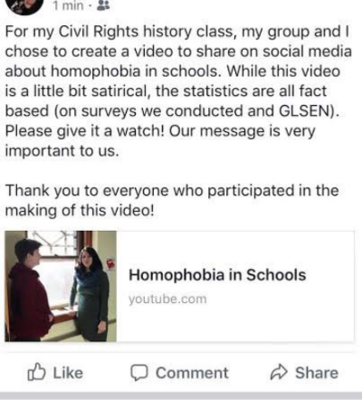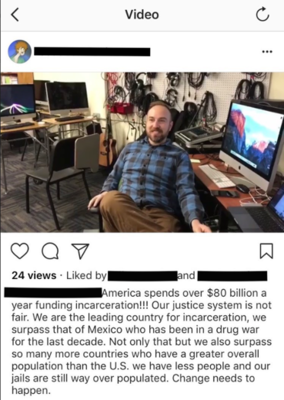Overview*
In this course, the teacher introduced the Ten Questions Framework by studying youth activists in the Civil Rights Movement and analyzing the activists’ decision making and actions via the Ten Questions. Thereafter, students chose human rights issues that mattered to them, got into small groups, and designed and completed an activism project to address their group’s issue. Issues included: supporting child Syrian refugees, LGBTQ+ harassment at school, mass incarceration in the U.S., police violence, and climate change. Students’ products included: a public-awareness and fundraising campaign for a Syrian refugee organization; a podcast and PSA video about mass incarceration; videos showing examples of LGBTQ+ harassment and discrimination that occur in schools and how to correct them; a movie about police violence and its impact on male teenagers. At the end, students presented to the class about their projects.
Context: 11th/12th grade history elective examining Reconstruction, Jim Crow, and the Civil Rights Movement at a charter school in the Merrimack Valley. The class had 23 students. The teacher was teaching 3 preps and 4 classes, including the class in which this project took place.
Project Timeline: 5-6 week unit at the end of a one semester course.
Stage 1: Examine Self and Civic Identity
Question 1: Why does it matter to me?
Students reflected on what motivated civil rights activists, and then connected to what issues mattered most to them based on their own lives and identities. The lessons highlighted examples of young activists in the Civil Rights Movement to demonstrate that young people have always pushed society to change and improve. The goal in picking out young people throughout history who have made a difference was to motivate students who felt disempowered or cynical about change. Eventually, students documented why their chosen issue mattered to them in their project proposals, and came back to Question 1 throughout the project.
Stage 2: Identifying an Issue
Question 2: How much should I share?
Students were regularly asked to reflect on what self-protective measures they needed to engage in their projects productively, and to think about the possible consequences of using online platforms to spread their messages. For example, because two students working on an LGBTQ+ issue were not “out” to their families, they decided not to use their personal social media accounts in their projects. Students were also asked to authentically and honestly share with their group members what they needed from one another, both to build group cohesion, and to practice collaboration skills.
Stage 3: Researching and Investigating
Question 3: Dow do I make it about more than myself?
Question 4: Where do we start?
Question 5: How can we make it easy and engaging for others to join in?
Question 10: How can we find allies?
Students planned their projects in their proposals and were asked to consider these questions as part of that planning process. The teacher gave them feedback and students revised their proposals after conferencing with the teacher.
Stage 4: Developing an Action Plan
Question 3: Dow do I make it about more than myself?
Question 4: Where do we start?
Question 5: How can we make it easy and engaging for others to join in?
Students planned their projects in their proposals and were asked to consider these questions as part of that planning process. The teacher gave them feedback and students revised their proposals after conferencing with the teacher.
Question 6: How do we get wisdom from crowds?
Question 7: How do we handle the downside of crowds?
Question 10: How can we find allies?
All of the students’ projects targeted a wider audience than our class, so they all thought about how to engage people with different perspectives, the logistics of doing so, and the challenges that might arise. For example, the group raising money for a Syrian refugee organization planned their marketing around the times of day and locations when the most students would be available.
Stage 5: Taking Action
Question 8: Are we pursuing voice or influence or both?
Question 9: How do we get from voice to change?
Students’ projects ended up primarily in the “voice” category with the goals of raising awareness about their issues. Students considered in their project proposals how they could create more systemic and policy-based change in different versions of their projects.
Stage 6: Reflecting and Showcasing
Question 1: Why does it matter to me?
Question 8: Are we pursuing voice or influence or both?
Question 9: How do we get from voice to change?
Students presented their projects to one another and reflected on their successes and challenges, and about what their work meant to them. Students reflected authentically on their theory of change, action plan, and about their own roles in the fostering change. They were asked to articulate how their own beliefs influenced the work when reflecting during the final presentation.

|

|
* This case is included to Civics Project Guidebook (DESE, 2019, pp. 37-8). We reintroduce it on this site by courtesy of the DESE.
